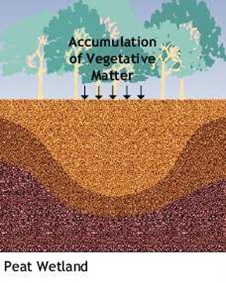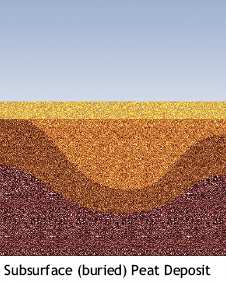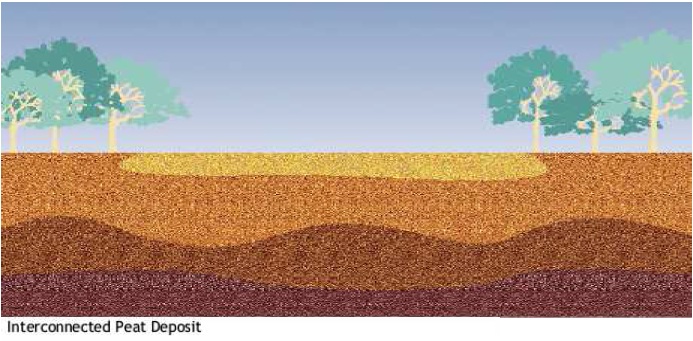Minimising the impacts of peat smoke

Lake Carabooda Peat Fire
Source: DEC Aerial Photograph
What is peat smoke?
Smoke is a complex mixture of substances produced during fuel combustion. Major components include:
- particulate matter (soot)
- carbon monoxide
- organic gases.
The composition of smoke will vary depending upon:
- the fuel source
- moisture levels
- fire temperature.
Peat smoke differs from normal wood smoke because of what is in the peat and how it burns.
Peat consists of partially decomposed vegetation and contains varying amounts of carbon, sulphur and nitrogen compounds.
When a fire occurs these compounds produce gases that may be very odorous and irritating.
Peat smoke also tends to be thicker than the smoke released by other vegetation fires.
This is because peat typically smoulders (a slow, low temperature form of combustion) rather than burning with an open flame.
The low temperatures result in incomplete combustion, which produces higher amounts of gas and discharges significant quantities of fine particulate matter.
Where is peat found?
Peat is generated gradually in wetlands through the build-up of partially decayed vegetation.
Peat sources can be found above ground or buried many metres below the soil surface.
Wetlands close to each other may be interconnected by subsurface peat deposits.
There are numerous wetlands distributed across Western Australia.
The Swan Coastal Plain, which extends along the coast between Guilderton and Busselton, consists of a progression of wetland and former wetland areas.
This area includes the Perth metropolitan district and is the region of greatest residential occupation and growth in Western Australia.
Many new and existing residential locations are therefore in close proximity to peat areas that may become prone to catching fire.




Why peat fires are an emerging problem
Western Australia’s drying climate, combined with increasing groundwater use, has contributed to an escalated occurrence of peat fires in recent years.
Peat has a high carbon content and is naturally porous.
Therefore, once dry, peat areas are highly vulnerable to ignition and the resulting fires are almost impossible to extinguish without re-establishing natural groundwater levels.
In such circumstances, natural heat sources such as lightning strikes, bushfires and even extreme daytime temperatures may initiate a peat fire.
Human activities such as welding, machinery operation and uncontrolled backyard burn-off may also be sources of ignition.
The potential public health impact of peat fire events has also increased as the Western Australian population continues to grow.
In the past a separation distance was maintained between wetlands and residential areas.
Recent population pressures have resulted in houses being built closer to wetland locations.
High density occupancy may be noticed in suburbs affected by peat smoke.
The increased groundwater use that may occur in these areas further exacerbates the problem.
Response to peat fire events
Local government is responsible for informing the public on all matters relating to local peat fire events.
Most importantly, this includes alerting the public to hazardous air quality conditions and providing advice on appropriate actions to protect the health of residents.
Local government is supported in this task by the Department of Health and the Department of Parks and Wildlife (DPAW).
Air quality monitoring
Establishing approximate smoke levels may be achieved simply by assessing visibility.
This approach is valuable to first responders (fire fighters, local rangers and DPAW) to determine whether health warnings or other immediate action is required.
Visibility may also provide a useful tool for ongoing monitoring of a smouldering peat fire.
A rough guide between visibility and potential health impacts is provided in the section below.
More detailed assessment may be undertaken using specialised monitoring equipment.
Air quality monitoring of this nature is commonly co-ordinated through local government and the DPAW, with health advice provided as appropriate by the Department of Health.
Levels of particulate matter (soot) in peat smoke are determined using methods that can continuously track changes in concentration.
The information may then be examined to evaluate both the general conditions that are experienced by most people and potentially more hazardous peak levels of smoke.
Where smoke levels are found to present a health concern, public notice and appropriate warnings are given.
Ongoing fire management
Fire fighters, local rangers or environmental health officers may be responsible for monitoring smouldering peat fires to ensure that flare-ups (sudden transitions to flame combustion) are controlled and that air quality does not significantly degrade.
Observations made during ongoing monitoring of peat fires help to inform the air quality assessment process and may indicate whether the DPAW or the Department of Health should be involved at various stages.
Clean air facilities
Clean air facilities may be established by local governments in areas regularly affected by smoke.
These designated buildings provide a safe place for people to move to when smoke conditions are causing distress or may be hazardous to their health.
Where clean air facilities are available, it is recommended that individuals with pre-existing respiratory or cardiac problems, the elderly and asthmatics utilise these locations during significant smoke events.
To improve the response to smoke events of all descriptions, the Department of Health strongly encourages the identification of buildings that may be used as clean air facilities in all residential areas.
To find out where clean air facilities may be located in your area, please contact your local government (external site).
Restrictions and penalties
Intentional ignition of peat fires or negligent behaviour leading to the ignition of peat areas is an offence.
To report any suspicious activity, negligent behaviour or intentional ignition of peat fires in your area, please contact your local government.
Your local government may also enforce local laws to control burning in open places or to restrict access to vulnerable wetland areas.
This may involve the use of penalty infringement notices (on the spot fines).
The Department of Health supports the development of local laws to help improve the management of potential smoke nuisance.
Peat smoke and your health
As peat burns, large amounts of gases and smoke are released that may affect your health.
Only your doctor can advise you of your specific health situation.
However, the effects experienced from peat smoke are generally temporary and should abate as smoke levels decrease.
Many factors will determine how you may be impacted by peat smoke including:
- how thick it is
- how long you are in it
- your age
- your general state of health.
It is a good idea to take steps to avoid breathing in peat smoke, even if you are healthy.
Particulate matter
The fine particles released from peat fires pose the greatest risk to your health.
When these particles get into your eyes and lungs, symptoms of irritation such as coughing, wheezing and sore eyes are commonly experienced.
As smoke levels decrease these symptoms will become less pronounced and eventually cease.
At higher levels the symptoms are more severe and may affect your normal activity.
In asthmatics the irritation of the lungs caused by particles released from peat fires may trigger a severe asthma attack.
Elevated levels of particulate matter are also known to aggravate pre-existing chronic respiratory and cardiac conditions, increasing the risk of severe health outcomes in affected individuals.
Odorous and irritant gases
Peat smoke includes a wide variety of components that have an offensive odour or are irritating.
These emissions can cause a variety of symptoms including:
- sore eyes and throat
- irritation of the nose
- itching or burning sensation of the skin
- difficulty breathing
- nausea
- headache.
Individual response to odours and irritants may differ widely.
Smoke that causes little discomfort to one person may significantly distress another.
However, symptoms are temporary and should cease within a short period of time after removing yourself from peat smoke affected areas.
Groups at greater risk from peat smoke
Infants and children are more susceptible to the effects of smoke inhalation as:
- they generally have higher inhalation rates
- their lungs are still undergoing development.
The elderly are more likely to be affected from peat fire smoke as they often:
- have reduced lung function
- have less capacity to recover from stressful events
- are generally more likely to have pre-existing heart or lung disease.
Pre-existing heart or lung disease is a significant risk factor for adverse health outcomes related to peat fire smoke inhalation.
People with such conditions are likely to experience health impacts at lower smoke levels than the general population and suffer more detrimental effects.
Asthmatics may be highly sensitive to the various irritant compounds contained in peat smoke.
It is possible for a severe asthmatic response to be provoked at relatively low levels of exposure.
How to protect yourself from peat smoke
Limiting your exposure to peat smoke is essential to protect the health of you and your family, especially if you are in a group that may be at greater risk.
There are also several actions that you can take to reduce the effects of the peat smoke you are exposed to.
Stay Indoors
A well-sealed house or building can provide some protection against peat smoke.
The amount of smoke experienced indoors may be as much as a third less of the smoke found in outdoor air.
However, the fine particles produced when peat burns will readily penetrate most houses.
If smoke levels are high for more than a few hours you should consider relocating to a clean air facility or a non-affected area until the smoke abates.
When you are indoors, keep windows and doors shut to reduce the intrusion of smoke into your home.
Also make sure that you are not generating more airborne particles inside your house.
- Do not vacuum as this can release dust from your carpets or the vacuum bag.
- Refraining from burning any materials such as wood (wood fires), candles and incense.
- Do not use gas ovens.
- Do not smoke.
Air conditioning can create negative pressure and draw air and smoke inside your house.
Do not use your air conditioner unless it can be operated in a mode that recirculates inside air.
Some air conditioners can be fitted with a high efficiency particulate (HEPA) filter that will capture the particles in smoke and may significantly assist in maintaining good indoor air quality.
Peat fires are difficult to extinguish and smoky conditions are likely to persist and fluctuate for many months.
Whenever there is a break in the smoke you should take advantage of this by:
- airing out your house
- vacuuming
- completing necessary outdoor tasks.
Seek respite
If you are being affected by peat smoke and the level of smoke does not appear to be changing or is getting worse, often the best course of action is to seek respite elsewhere.
This is particularly advisable if you are in a higher health risk group.
During significant smoke events relocation to a clean air facility or building with effective air conditioning is recommended.
When smoke is less intense or more localised you may gain sufficient relief at a local park, shopping centre or other public facility where effects from the smoke are less noticeable.
It may be appropriate to temporarily stay with a friend or relative if you are unwell or if heavy smoke is anticipated to last overnight.
Limit physical activity
During exercise you tend to breathe harder and more frequently.
This increases the amount of smoke that you inhale and brings more pollutants deep into the lungs.
Exercise also places additional stress on your heart.
Physical activity should therefore be kept to a minimum during any smoke event, especially by those with heart or respiratory conditions.
Avoid any activity that may lead to over exertion.
Manage pre-existing health conditions
Contact your doctor to discuss ways to protect your health and that of your family if you:
- have asthma
- have heart or lung disease
- are an older adult
- are pregnant or have children.
If you live in an area prone to peat fires, talk to your doctor so you can plan ahead.
Commonly asked questions and answers
Why can’t the Department of Fire and Emergency Services (DFES) put out the fire?
Unlike vegetation fires, peat fires burn fuel sources buried deep underground.
As a result, they are almost impossible to extinguish without re-establishing the natural water levels of the area.
The use of various fire-fighting techniques has been investigated by the DPAW and the DFES.
However, these studies have had limited success. Most peat fires are unlikely to be extinguished until there is an extended period of rain.
Will a dust mask help reduce my exposure to peat smoke?
Most dust masks are designed to trap large particles such as saw dust and will not help.
Small particles that cause the most harm to your health will not be trapped by the mask and so offer little protection from peat smoke.
However, a dust mask designed to filter fine particles (a P2 or P3 mask) will assist in reducing the amount of smoke particles you breathe in.
I don’t have re-circulating air conditioning and I want to keep my windows open. What can I do?
When remaining indoors during a peat smoke event, windows and doors should remain shut.
However, due to potential heat stress in hot weather, closing doors and windows when smoke levels are high can be dangerous to your health.
Under such circumstances it is advised that you seek alternative accommodation.
Peat smoke is making my house and clothes stink. What can I do?
Some gases released in peat fire smoke produce unpleasant smells.
As peat fires can continue for substantial periods of time (days, months, years), communities living nearby can be exposed to constantly foul smelling air.
Unfortunately little can be done to eliminate peat fire odours.
Keeping doors and windows closed may help to reduce these smells in your home; otherwise you may wish to temporarily stay elsewhere to achieve some relief.
More information
Contact Environmental Health Services at your
local government (external site).
Remember
- The fine particles released from peat fires pose the greatest risk to your health.
- Peat smoke includes a wide variety of components that have an offensive odour or are irritating.
- Infants and Children are more susceptible to the effects of smoke inhalation.
- If you live in an area prone to peat fires, talk to your doctor so you can plan ahead.
This publication is provided for education and information purposes only. It is not a substitute for professional medical care. Information about a therapy, service, product or treatment does not imply endorsement and is not intended to replace advice from your healthcare professional. Readers should note that over time currency and completeness of the information may change. All users should seek advice from a qualified healthcare professional for a diagnosis and answers to their medical questions.